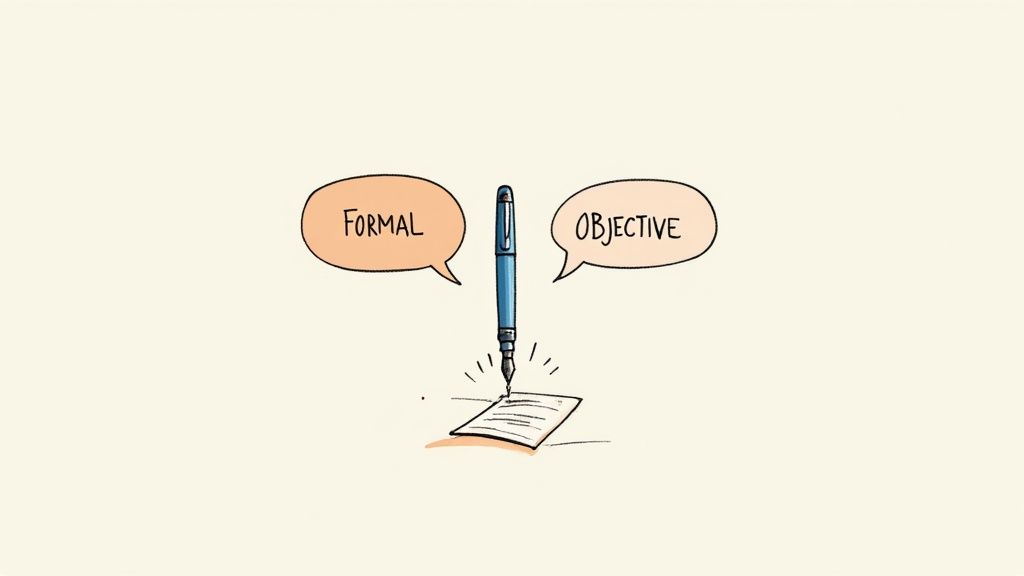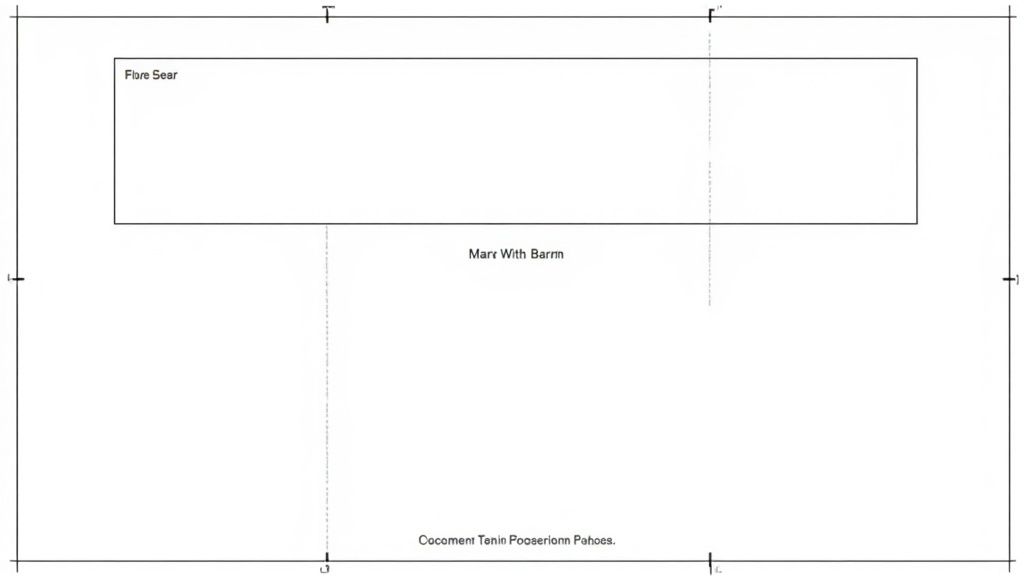Why Academic Writing Feels Like Learning A Secret Language
Ever walked into a room and felt like everyone's speaking a language you should understand, but the pieces just don't fit? That's the experience many have with academic writing. It's not about being deliberately difficult; it's about pinpoint accuracy. Think of it like explaining your day to a friend versus presenting a scientific breakthrough – both are communication, but the details and formality shift dramatically. Academic writing aims for clarity that leaves no room for misunderstanding, especially when sharing important research.
This need for precision is why academic writing uses established conventions. It's like a universal translator for knowledge. A biologist in Brazil can grasp the methods of a historian in Japan, even if they don't speak the same language, because the structure of academic communication bridges the gap. This shared understanding is crucial for progress across different fields. Imagine building a skyscraper where each team speaks a different construction language – chaos, right? Academic writing provides the common blueprint.
Structure and Conventions: The Building Blocks of Clarity
So, what are these conventions, and why are they so important? Structure is key. Just as a building needs a foundation, supports, and walls, an academic paper needs a clear introduction, logical body paragraphs, and a strong conclusion. This framework helps complex ideas unfold in an easy-to-follow way, like a guided museum tour. Without it, readers can get lost in a sea of information.
Academic writing also uses specific terminology and citation styles. These aren't just random rules; they have important jobs to do. Standardized terms prevent confusion, ensuring everyone's on the same page. Citation styles, such as APA, MLA, and Chicago, provide a clear record of sources, letting readers verify information and trace the development of ideas. APA, MLA, and Chicago are essential tools, each with its own formatting rules. APA is commonly used in social sciences, while MLA is often preferred in the humanities. The choice depends on the field and audience. Understanding these styles is key for academic success, facilitating clear communication and contributing to scholarly discussions. Explore academic writing styles in greater depth.
From Opaque Jargon to Engaging Narrative
Clarity doesn't have to mean dry writing. The best academic writers weave a narrative, making difficult topics understandable without sacrificing precision. They do this with clear comparisons, compelling examples, and a strong authorial voice. It's about going beyond just facts and figures to create a story that engages the reader intellectually.
For instance, instead of simply stating a statistic, a skilled writer might illustrate its meaning with a real-world example. This clarifies the data and makes it relatable, more memorable, and more impactful. This balance between authority and accessibility makes academic writing truly effective. It's not about speaking a secret language; it's about translating complex ideas into a language everyone can understand.
Decoding APA, MLA, and Chicago: The Big Three Explained
Think of academic citation styles like choosing a navigation app for a road trip. APA, MLA, and Chicago will all get you to your final destination (a properly cited paper), but they each have their own preferred routes and features. APA, favored in social sciences, is like a reliable GPS that prioritizes knowing when things happened. Dates are front and center, like knowing the latest traffic updates. MLA, commonly used in the humanities, is more like a scenic route, emphasizing the journey (and page numbers) alongside the destination, like appreciating the landmarks along the way. Chicago style, the versatile multi-tool, is like having a detailed atlas and a modern GPS, offering both footnotes and an author-date system.
Why These Styles Matter
These different "routes" aren't arbitrary. They reflect the values of different academic disciplines. In social sciences, understanding how recent research is is key, hence APA's emphasis on dates. For humanities scholars analyzing literature, pinpointing specific passages and ideas through page numbers is crucial, which is where MLA shines. Chicago, with its flexibility, caters to the diverse needs of fields like history and publishing. Even understanding how the publishing world operates can be helpful for academic writing. For instance, knowing how to write a book synopsis can offer surprising insights. The prevalence of APA Style, particularly within the social sciences, is significant. As of 2024, 53.6% of doctoral degrees are awarded in fields that typically use APA, underscoring its importance in areas like psychology, nursing, and social work. Discover more insights about APA Style.
Navigating the Nuances: Real-World Examples
Let's see these styles in action. Imagine you're citing a book. In APA, you'd focus on the author, year, and title. MLA prioritizes author, title, and page number. Chicago offers two primary options: footnotes/endnotes or the author-date system similar to APA. These seemingly small differences add up, shaping distinct academic conversations within each discipline.
Choosing the Right GPS for Your Academic Journey
So, how do you choose the right style? Your course syllabus or style guide should specify. If not, consult your instructor or refer to publication guidelines. Mastering these styles isn't just about following rules; it's about understanding the underlying principles behind each one. This understanding helps you adapt to various citation scenarios and engage more effectively within your academic community. It's like learning the local language – it allows you to connect with others and understand their perspectives.
To help visualize the key differences, let's take a look at a quick comparison table:
Quick Comparison: APA vs MLA vs Chicago Style
| Style | Best For | In-Text Citations | Reference Page | Date Placement |
|---|---|---|---|---|
| APA | Social Sciences | (Author, Year) | Author, Date, Title | Prominent |
| MLA | Humanities | (Author, Page Number) | Author, Title, Source | Less Emphasized |
| Chicago | History, Publishing | Footnotes/Endnotes or (Author, Date) | Varies based on format | Varies based on format |
By grasping the "why" behind each system, you move beyond rote memorization to a genuine understanding, transforming citation from a chore into a powerful tool for academic success. This deeper understanding connects you more strongly with your chosen field and empowers you to contribute meaningfully to scholarly discussions.
Building Papers That Flow Like Great Conversations
The best academic papers don't just present information; they tell a story. They pull you in and guide you seamlessly through a complex landscape of ideas, leaving you with a sense of satisfaction and newfound understanding. Think of it like hosting a dinner party: you wouldn't just throw food on the table, would you? You carefully craft the experience, from the initial invitation to the final goodbyes.
Crafting Introductions That Spark Interest
The introduction is your appetizer – it sets the stage and whets the reader's appetite. Instead of a bland statement of your topic, try something more engaging. Imagine starting a conversation with, "I'm going to talk about X." Now, imagine starting with a captivating question, a relatable anecdote, or a startling statistic. Which approach do you think would grab your attention?
Developing Body Paragraphs That Build Momentum
Your body paragraphs are the main course – the substance of your argument. Each paragraph should flow logically from the previous one, building momentum and adding depth to your analysis. Transition techniques are crucial here. Instead of using robotic transitions like "firstly," "secondly," and "thirdly," try using phrases that illustrate the relationship between ideas. For example, "however" signals a contrast, "furthermore" adds a supporting detail, and "this implies" clarifies a consequence.
Creating Conclusions That Synthesize, Not Just Summarize
The conclusion is your dessert – the satisfying culmination of your argument. It's not just a rehash of what you've already said. It's an opportunity to synthesize your findings and explore their broader implications. Ask yourself: What are the key takeaways? How does my research contribute to the ongoing scholarly conversation? You want your reader to walk away with a new perspective, not just a summary of what they've just read. For more guidance on structuring essays effectively, check out these essay structure examples.
Adapting Your Structure to Different Paper Types
Different types of papers call for different structural approaches. Just as a chef uses different techniques to prepare different dishes, you'll need to adapt your writing style to fit the specific requirements of each assignment. An empirical study, for instance, might unfold like a detective story, presenting evidence and drawing conclusions. A theoretical analysis, on the other hand, might resemble a philosophical dialogue, exploring different perspectives and arguments.
Maintaining Your Voice and Passion
Academic writing has its conventions, but that doesn't mean your writing has to be dry and impersonal. Let your passion for the subject shine through! Use vivid language and compelling examples to bring your ideas to life. Think of it as having a deep conversation with a colleague – informative, insightful, and engaging. It's about finding the balance between rigor and personality.

Making Citations Work For You, Not Against You

Citations are often seen as a chore, a necessary evil of academic writing. But what if I told you they could actually strengthen your work and make you a more persuasive writer? Instead of roadblocks, think of citations as bridges, connecting your ideas to the vast network of scholarly knowledge. Skilled writers use citations strategically, weaving them seamlessly into their arguments to enhance, not interrupt, their flow.
Introducing Sources With Authority
Imagine you're at a conference, and you want to bring a guest speaker on stage. You wouldn't just plop them down and say, "Here's John." You'd introduce them, explain their expertise, and tell the audience why their perspective is valuable. Citations work the same way. You need to frame your sources, explaining why each one matters to the conversation.
Instead of simply inserting a citation after a sentence, try something like, "As Dr. Smith, a leading scholar in the field, argues in her seminal work…" This tells the reader why Dr. Smith's voice is relevant and lends weight to your argument.
Direct Quotes vs. Paraphrasing: Choosing the Right Tool
Think of direct quotes and paraphrases like video clips and narrated summaries. Sometimes, the raw footage—the direct quote—has an impact that a summary can't capture. Other times, a concise paraphrase gets the point across more effectively. Knowing which tool to use is key to crafting a compelling argument.
Also, remember to maintain your own analytical voice, even when incorporating other people's ideas. Citations should support your argument, not replace it. You're the author; the sources are there to bolster your narrative.
Mastering Tricky Citation Scenarios
Style guides like APA, MLA, and Chicago are invaluable resources, but they can't cover every situation. What happens when you encounter a source with no publication date, twelve authors, or an online article that seems to change format every day?
Don't panic! By understanding the underlying principles of each citation style, you can navigate these tricky situations with confidence. It's like having a solid grasp of grammar: even when you encounter a sentence structure you haven't seen before, you can usually figure out how it works.
Let's look at some common citation challenges and how to tackle them in different styles:
Common Citation Scenarios and Solutions
| Scenario | APA Format | MLA Format | Chicago Format |
|---|---|---|---|
| Missing Publication Date | (n.d.) | n.d. | n.d. |
| Multiple Authors (3+) | (Smith et al., 2023) | (Smith et al.) | (Smith et al. 2023) |
| Online Article (unstable URL) | Use a persistent link (DOI) if available; otherwise, cite the database. | Use a persistent link (DOI) if available; otherwise, cite the webpage. | Use a persistent link (DOI) if available; otherwise, cite the webpage. |
This table summarizes some common issues. Notice how each style has its own conventions, but the goal remains consistent: to provide enough information for your reader to locate the source.
Citations as a Foundation for Credibility
Ultimately, correct citation isn't just about avoiding plagiarism; it's about building your credibility and showcasing the depth of your research. By using citations accurately and thoughtfully, you demonstrate that you've engaged with the relevant scholarship and are contributing meaningfully to the ongoing academic dialogue. This strengthens your work and establishes you as a knowledgeable voice in your field. As you become more comfortable with citation practices, they'll become second nature, allowing you to focus on what truly matters: developing and sharing your insightful ideas.
Finding Your Academic Voice Without Losing Your Soul
Academic writing has a reputation. Dry. Stiff. Robotic. But here's a secret: it doesn't have to be that way. The best academic writing blends a professional tone with genuine authenticity. Think of it like crafting the perfect cup of coffee – the right balance of strength and smoothness.
Striking the Right Balance
So, how do you project authority without sounding like a dusty old textbook? One trick is using the active voice. Instead of "The research was conducted by the team," try "The team conducted the research." It's a small change, but it adds a punch of clarity and directness.
Another key ingredient is precise vocabulary. Choosing the right words is like using the right tools for the job. Vague language muddles your meaning, while clear language illuminates it.
Rhythm and Flow: Engaging Your Reader
Think about your favorite song. It likely has a mix of fast and slow parts, loud and soft moments. This variation keeps you engaged. Your writing should do the same. Mix short, impactful sentences with longer, more complex ones to create a rhythm that keeps your reader hooked. An AI writing assistant can be a helpful tool in refining this flow.
Interestingly, research shows a direct link between writing style and impact. A study of 28,774 articles across five social science disciplines found that writing style can actually influence citation rates. This underlines how important clear, engaging writing is for reaching a wider audience. Discover more insights about writing style and citation impact. Use ChatGPT for SEO might also be helpful for increasing your reach.
Objectivity and Passion: A Delicate Dance
Academic writing demands objectivity, but that doesn't mean your own voice can't shine through. Think of it like a skilled musician playing a classical piece. They follow the notes, but they also add their own interpretation and emotion. You, too, can maintain academic rigor while letting your passion for the subject peek through.
Adapting Your Tone for Different Audiences
Imagine explaining a complex topic to a five-year-old, and then explaining it to a college professor. You would naturally adjust your language and approach. The same applies to academic writing. Consider your audience – their background, knowledge level, and expectations – and tailor your writing accordingly.
By mastering these techniques, you can craft academic writing that is both rigorous and readable. It's about finding that sweet spot where your unique voice strengthens, not weakens, your scholarly contributions. It's about sharing your knowledge with the world in a way that is both informative and engaging.
Professional Formatting That Actually Makes Sense

Think of academic formatting like building a house. A style guide is your blueprint. It helps you lay a solid foundation, construct strong walls, and put on a beautiful roof. It ensures your final product is well-structured, polished, and ready to impress. It's not just about rules; it's about presentation.
Good formatting makes your work easier to read and understand. It helps your ideas shine.
Mastering the Essentials: Title Pages, Headers, and Page Numbers
Imagine trying to navigate a city without street signs or house numbers. A bit disorienting, right? Similarly, title pages, headers, and page numbers are the navigational tools of your academic paper. They guide your reader through your work, ensuring a smooth and enjoyable reading experience.
A title page introduces your work, headers keep readers oriented, and page numbers help them track their progress. For a practical example of how these elements work together, check out our guide on essay format example.
The Art of Spacing and Indentation: Giving Your Ideas Room to Breathe
Spacing and indentation are more than just visual aesthetics. They are crucial for clarity and readability. Think of spacing as the pauses in a musical piece. They allow the notes to resonate and prevent the melody from becoming overwhelming.
Indentation, like the structure of a well-organized outline, visually signals the relationships between your ideas. It shows how different points connect and build upon one another, creating a clear and logical flow.
Font Choices: Enhancing, Not Distracting
Choosing a font is like selecting the right outfit for an important occasion. It should be appropriate for the context and enhance your overall presentation. In academic writing, font choices should be professional, readable, and unobtrusive.
Avoid overly decorative fonts that might distract your reader from the content. Stick with classic, easy-to-read fonts like Times New Roman or Calibri, allowing your message to take center stage.
Time-Saving Formatting Techniques and Troubleshooting
We've all been there: struggling with formatting issues can feel like trying to untangle a giant ball of yarn. Frustrating and time-consuming! Learning time-saving formatting techniques and troubleshooting strategies can be a game-changer.
These skills streamline your writing process, freeing up your mental energy to focus on the most important aspect: developing and refining your ideas. Mastering these elements elevates your work, transforming it from a rough draft into a polished, professional piece.
Your Complete Academic Writing Success Strategy
Ready to transform your academic writing from a struggle into a consistent strength? This guide offers a practical, actionable strategy you can use right away, bringing together the core principles of strong academic writing. Think of it like your personal GPS, guiding you from initial brainstorming all the way to the final polish.
Building Your Toolkit: Stage-by-Stage Checklists
We'll provide you with checklists for each phase of the writing process. These checklists take the guesswork out of writing, ensuring you address every important element. This means no more late-night worries about missed citations or formatting slip-ups.
-
Topic Exploration: Hone your research question and pinpoint key resources.
-
Drafting: Organize your argument logically and back it up with solid evidence.
-
Revision: Refine your writing style, strengthen your arguments, and make sure everything is clear.
-
Formatting: Carefully follow the guidelines of your chosen style guide.
-
Finalization: Proofread meticulously and submit with confidence.
Troubleshooting and Habit Building
This guide also tackles common writing roadblocks. You'll find troubleshooting tips for those times you feel stuck, along with strategies for developing sustainable writing habits. For a truly successful strategy, it's important to incorporate established documentation best practices. This helps you build a consistent and efficient workflow, reducing stress and improving your writing over time.
Setting Realistic Goals and Celebrating Wins
This screenshot shows the APA Style website, a valuable resource for any academic writer. The site offers detailed guidance on all aspects of APA style, from formatting to citations. Learning to use resources like this is essential for developing strong academic writing skills.
We'll also help you set realistic writing goals and identify clear signs of progress. This allows you to celebrate your accomplishments along the way, boosting your confidence and motivation. After all, academic success isn't just about mastering technical skills; it's also about developing a positive relationship with the writing process itself.
Ready to reach your full academic writing potential? TextSpell offers AI-powered tools to enhance your writing, from grammar and style checks to citation assistance. Start writing with confidence with TextSpell!

